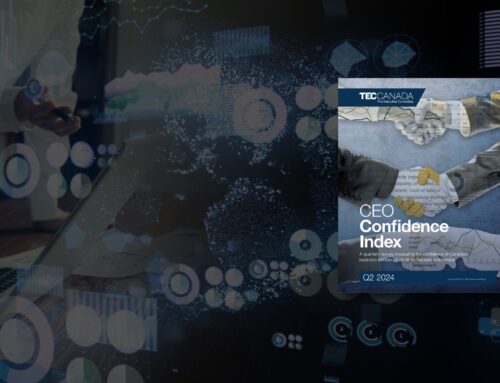How to Write Policies that Employees Want to Follow
In the complex journey of leading a small to medium-sized enterprise (SME), policy creation plays a pivotal role. How you talk to your stakeholders affects how your organization is seen and treated, both inside and outside.
Lewis Eisen, TEC speaker and expert in drafting policies, shares critical insights in this TEC Canada Deeper Insights Webinar. He goes into depth about how business owners and leaders can create policies that reflect their mission and values. This article explores Eisen’s advice, the importance of language in policy creation, and the consequences of neglecting this detail. If you’re exploring how to write an employee handbook for a small business or a code of conduct, start here.
Company Policies and Procedures: Creation at a Glance
Companies use policies and procedures as an essential form of communication with their employees and customers. Personal interactions can’t be used in every instance when information needs to be relayed, so a policy or a company code is created. This can be anything from an employee code of conduct, a company privacy policy, an overtime policy, or an employee handbook. On the customer side, it could be anything from where to line up, where not to trespass, or how to use a certain service/technology.
How these policies are worded can have a beneficial or detrimental effect on our organization.
“Workplace culture has changed over the years. The goal today is willing cooperation rather than begrudged obedience.”
-Lewis S. Eisen, JD CIP | TEC Speaker, Coach, Facilitator, Writer
Fostering a Supportive Organization
Eisen poses an essential question: “Do our policies reflect our corporate ethos?” highlighting the importance of policy alignment with a company’s fundamental beliefs. For business owners and leaders of SMEs, the connection between policies and company values is crucial for cultivating a supportive and understanding organizational ethos. Policies act as the blueprint for company operations; discrepancies can cause confusion, employee dissatisfaction, and a decline in engagement.
Examples of the Influence of Constructive Communication
As Eisen suggests, always assume people aim to do what’s right when drafting policies and acknowledge that language can either uplift or demoralize. Policies framed positively not only promote adherence but also bolster a culture of optimism and empowerment.

As Eisen suggests, always assume people aim to do what’s right when drafting policies and acknowledge that language can either uplift or demoralize. Policies framed positively not only promote adherence but also bolster a culture of optimism and empowerment.
Negatively Worded Policies – An example of a poorly formulated policy might be, “Aggressive behavior is unacceptable,” or “Employees must wash their hands.” Despite their clarity and logic, these two examples lead with a confrontational stance. It forces the customer or employee into a low-status position, which is not uplifting or conducive to engagement.
Truthfully, this wording creates a conflict of interest and makes the rules less likely to be followed. No one like being talked down to, which is exactly what these policies suggest.

Positively Worded Policies– In contrast, inspired by Eisen’s principles, the policies could be positively stated as “We are dedicated to treating everyone with respect and kindness and expect the same in return,” and “Please wash your hands for a safer work environment for everyone.” This not only clarifies expectations but does so in a way that encourages positive interactions, puts employees and/or customers at an even status with the organization, and reflects effective communication with mutual respect.
A Handbook for Policy Principles
When crafting a policy, Eisen identifies two key principles—touched on above—to help ensure they are received positively.
- Assume positive intent: We often jump to conclusions and criticisms, usually based on one past bad example. Unfortunately, these bad examples are often what cause a policy to take effect in the first place.
For example, if an employee steals office supplies, a policy of “theft will not be tolerated and will result in corrective action” will be put in place. However, we need to take a step back from the single scenario and assume that most people viewing this policy have good intentions and aren’t looking to be malicious and steal.
If this sentiment can be carried out in practice, then the tone and wording of the policy will be welcoming, not confrontational, and encourage adherence through mutual benefit. The above example could be reworded to “Please put items back where you found them to ensure we can maintain a secure and productive workplace environment for everyone.”
- Avoid the parent-child dynamic: This sort of top-down tone often provokes an unwillingness to obey. Thinking back to childhood, if a parent declares certain rules must be followed without providing context, the child is likely to rebel despite the parent’s wishes. Another way to avoid this dilemma is to clearly explain why certain rules are in place.
For example, when drafting an employee handbook for a small business’s design elements, rather than stating “these guidelines must be followed,” explain why certain colours or logos are used so the employee is fully informed. The result is educational and empowering. Then state, “These are the following logos you can use.”
Using the word “can” rather than “must” is just as clear and far less aggressive. Providing context is the difference between being a transparent organization versus treating employees as having lower status and on only a need-to-know basis.
The Impact of Overlooking Policy Language
These instances underscore a frequent oversight in policy drafting: not considering the policy’s reception by its audience. Policies that are understandable, reasonable, and regarded as fair by all involved not only ensures smoother implementation but also boosts positive workplace relationships.
The selection of words, sentence construction, and overall tone significantly affect policy reception and compliance within an organization. Policies perceived as unfriendly or patronizing will erode trust and hinder the achievement of their goals.
Additionally, it can harm the organization’s external reputation, impacting customer relations and possibly resulting in business losses. Eisen’s teachings remind us that policies are not merely administrative tools but are crucial in molding organizational culture and perceptions.
Conclusion
By dedicating meticulous care to policy wording, focusing on constructive communication, and aligning with corporate values, SMEs can foster a supportive, transparent, and dynamic work environment. Effective policies lay the groundwork for a thriving organizational culture and customer satisfaction. Let your policies mirror your vision, values, and voice, guiding your team toward collective success and growth.
At TEC Canada, we pair business leaders and peers in groups with the guidance of an experienced TEC Chair. Our unique peer-group model is ideal for leadership development and finding solutions to every day and big-picture challenges, and access to timely thought leadership from speakers such as Lewis Eisen is a core part of the TEC Canada member experience.




